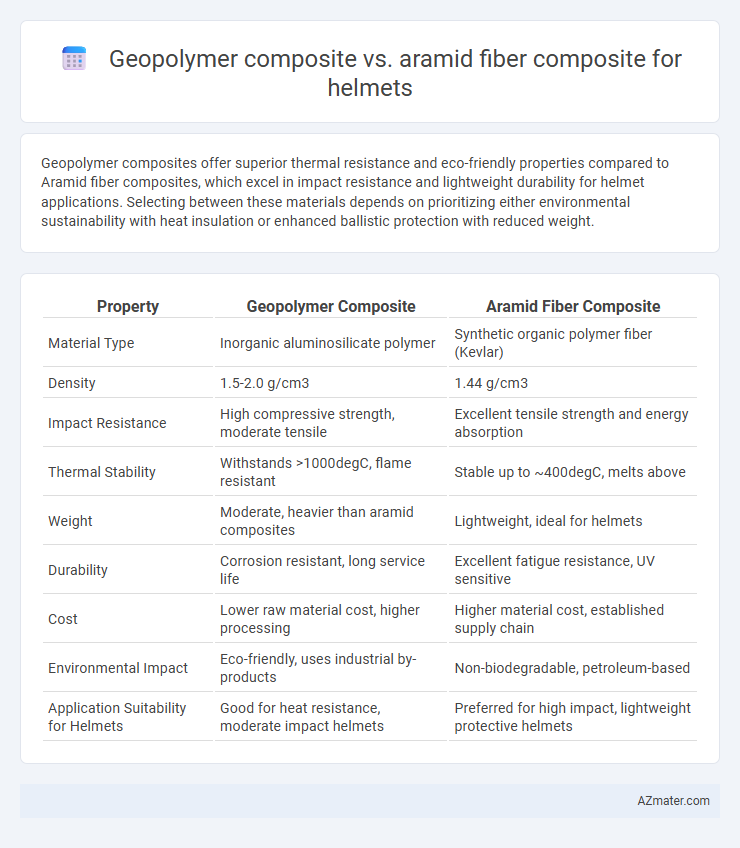Geopolymer composites offer superior thermal resistance and eco-friendly properties compared to Aramid fiber composites, which excel in impact resistance and lightweight durability for helmet applications. Selecting between these materials depends on prioritizing either environmental sustainability with heat insulation or enhanced ballistic protection with reduced weight.
Table of Comparison
| Property | Geopolymer Composite | Aramid Fiber Composite |
|---|---|---|
| Material Type | Inorganic aluminosilicate polymer | Synthetic organic polymer fiber (Kevlar) |
| Density | 1.5-2.0 g/cm3 | 1.44 g/cm3 |
| Impact Resistance | High compressive strength, moderate tensile | Excellent tensile strength and energy absorption |
| Thermal Stability | Withstands >1000degC, flame resistant | Stable up to ~400degC, melts above |
| Weight | Moderate, heavier than aramid composites | Lightweight, ideal for helmets |
| Durability | Corrosion resistant, long service life | Excellent fatigue resistance, UV sensitive |
| Cost | Lower raw material cost, higher processing | Higher material cost, established supply chain |
| Environmental Impact | Eco-friendly, uses industrial by-products | Non-biodegradable, petroleum-based |
| Application Suitability for Helmets | Good for heat resistance, moderate impact helmets | Preferred for high impact, lightweight protective helmets |
Introduction to Helmet Materials
Helmet materials significantly impact safety and performance, with geopolymer composites offering superior thermal resistance and lightweight durability due to their inorganic polymer matrix. In contrast, aramid fiber composites excel in impact resistance and tensile strength, attributed to tightly woven synthetic fibers like Kevlar. Selecting between these materials depends on balancing heat protection and structural integrity in helmet design.
Overview of Geopolymer Composites
Geopolymer composites for helmets consist of inorganic polymer matrices derived from aluminosilicate materials, offering high thermal stability and excellent fire resistance compared to conventional organic composites. Their inherent chemical resistance and low environmental impact make them a sustainable choice for personal protective equipment. The enhanced mechanical strength and durability of geopolymer composites contribute to improved impact absorption and helmet longevity.
Introduction to Aramid Fiber Composites
Aramid fiber composites, known for their exceptional strength-to-weight ratio and high impact resistance, are widely used in helmet manufacturing for enhanced protection and durability. These composites incorporate aramid fibers such as Kevlar, which provide superior energy absorption and resistance to penetration compared to traditional materials. Their thermal stability, chemical resistance, and lightweight nature make aramid fiber composites a preferred choice in advanced safety gear applications.
Mechanical Properties Comparison
Geopolymer composites exhibit high compressive strength and excellent thermal stability, making them ideal for impact absorption in helmet applications. Aramid fiber composites offer superior tensile strength, exceptional flexibility, and high energy absorption, enhancing resistance to penetration and fracture during collisions. Comparative studies indicate that while geopolymer composites provide robust structural integrity, aramid fiber composites deliver enhanced toughness and durability under dynamic loads.
Impact Resistance and Protection Performance
Geopolymer composites exhibit superior impact resistance due to their high stiffness and energy-absorbing capabilities compared to Aramid fiber composites, which offer excellent tensile strength and flexibility but may deform under extreme impact. The inorganic matrix of geopolymer composites enhances protection performance by providing better thermal stability and resistance to abrasion, crucial for helmet durability in harsh environments. While Aramid fibers excel in shock absorption and lightweight properties, geopolymer composites ensure long-lasting rigidity and impact dissipation, making them highly effective for protective helmet applications.
Weight and Ergonomics
Geopolymer composites offer a lightweight solution for helmet construction, typically reducing overall weight compared to traditional materials. Aramid fiber composites, such as Kevlar, provide high strength-to-weight ratios, enhancing impact resistance while maintaining a low helmet mass that supports ergonomics. The combination of reduced weight and superior flexibility in aramid fiber composites promotes better comfort and fit, crucial for extended wear in protective headgear.
Durability and Environmental Resistance
Geopolymer composites exhibit superior environmental resistance due to their inherent fire, chemical, and UV stability, making them highly durable under extreme conditions compared to aramid fiber composites. Aramid fiber composites offer excellent impact resistance and tensile strength but are more susceptible to degradation from moisture and UV exposure over time. The enhanced thermal stability and corrosion resistance of geopolymer composites contribute to longer helmet lifespan in harsh environments, while aramid composites require protective coatings to maintain durability.
Manufacturing Processes and Scalability
Geopolymer composite helmets utilize a chemical curing process involving alkali-activated binders, enabling low-temperature processing and reduced energy consumption compared to the high-temperature curing and autoclave requirements of aramid fiber composites. The geopolymer manufacturing process allows for easier scalability due to the use of readily available raw materials and simpler mold designs, while aramid fiber composites demand precise fiber layup and longer curing cycles, limiting rapid production scaling. This difference makes geopolymer composites a cost-effective option for mass production in helmet manufacturing, whereas aramid composites offer superior mechanical performance but with higher processing complexity and scalability constraints.
Cost Analysis and Market Availability
Geopolymer composite helmets offer cost advantages due to the use of abundant raw materials like metakaolin and industrial byproducts, resulting in lower production expenses compared to Aramid fiber composites, which rely on expensive fibers such as Kevlar. Market availability favors Aramid fiber composites, as they are widely adopted in military and commercial helmets with established supply chains, whereas geopolymer composites remain in developmental stages with limited commercial presence. Cost analysis reveals geopolymer composites could disrupt the helmet industry by providing affordable alternatives, but scalability challenges and material performance validation are critical to broader adoption.
Future Prospects and Innovations in Helmet Materials
Geopolymer composites offer promising future prospects in helmet materials due to their high thermal resistance, environmental sustainability, and cost-effectiveness, making them ideal for protective gear advancements. Innovations in aramid fiber composites focus on enhancing impact resistance, lightweight properties, and durability through nanotechnology and hybrid fiber blends, pushing helmet performance to new safety standards. The integration of geopolymer and aramid fiber composites in hybrid helmets could revolutionize the industry by combining the advantages of both materials for superior protection and comfort.

Infographic: Geopolymer composite vs Aramid fiber composite for Helmet
 azmater.com
azmater.com